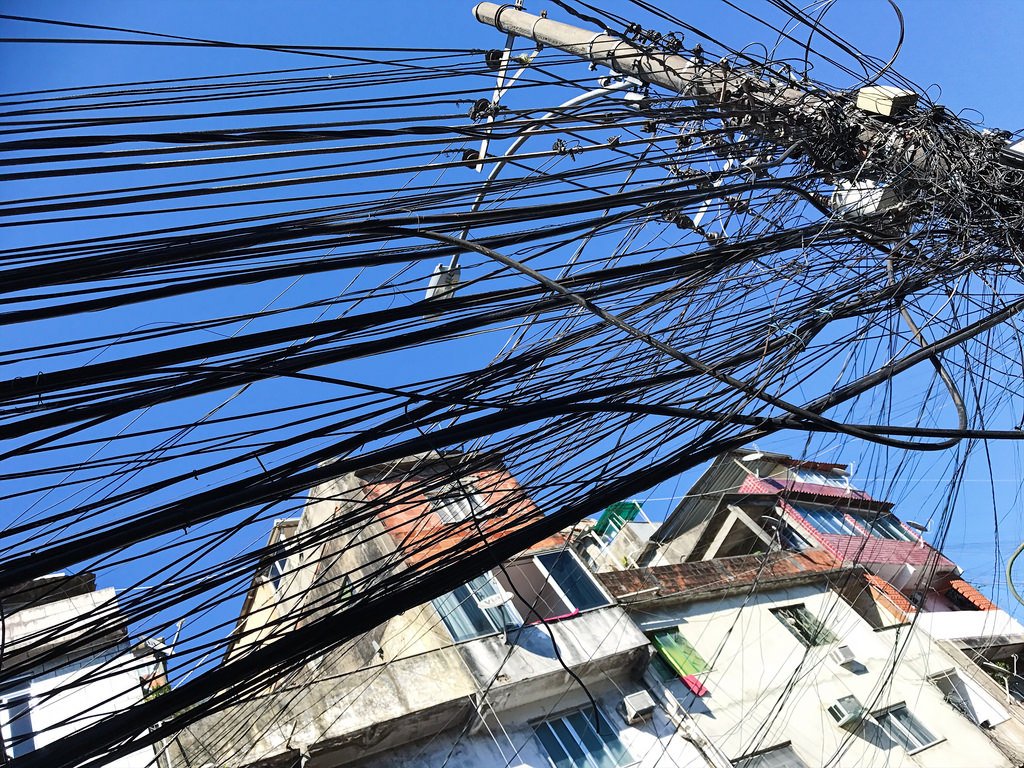What are the social and economic opportunities associated with the growth of Rio?
AQA GCSE Geography > Urban Issues and Challenges > Rio de Janerio > What are the social and economic opportunities associated with the growth of Rio?

The rapid expansion of Rio de Janeiro, driven by natural population growth and migration, has led to significant social and economic opportunities within the city. Compared to Brazil’s rural regions, Rio benefits from considerably higher levels of investment. This can be attributed to its historical role as the former capital, as well as its status as a major industrial hub and a key trading port. Infrastructure developments linked to the 2016 Rio Olympic Games, such as the creation of Line 4 of the Metro (photo A), further enhanced the city’s connectivity.
Rio attracts skilled international migrants who have contributed to economic growth by starting businesses and bringing specialised expertise. Residents of Rio generally enjoy better access to services like healthcare, education, and job opportunities compared to those in other parts of the country. Development indicators in the table below highlight the disparities between Rio and Brazil’s national average, illustrating how the city’s growth has created opportunities and made it a magnet for internal migrants seeking improved living conditions.
| Indicator | Brazil (2023) | Rio (2023) |
|---|---|---|
| Life expectancy at birth | 75.9 years | 77.2 years |
| Infant mortality rate | 11.0 deaths per 1,000 live births | 9.5 deaths per 1,000 live births |
| Literacy rate | 93.2% | 97.1% |
| Doctors per 1000 people | 2.81 | 3.44 |
Social opportunities in Rio de Janeiro
Health Care
Rio’s residents have access to free health care and better access to hospitals than in other parts of the country, particularly rural areas. There are three public hospitals in the city and six private hospitals.
As of 2023, Brazil had approximately 2.81 doctors per 1,000 people. In Rio de Janeiro, the physician density is notably higher. The city has a concentration of 3.44 doctors per 1,000 people. This reflects a common trend in Brazil, where urban centres often have more medical professionals than rural areas. Also, compared to living in the countryside, vulnerable people such as children and the elderly have better access to emergency care and vaccinations in Rio.
Since 2008, Rio de Janeiro has seen significant advancements in healthcare services, particularly in preparation for the 2014 World Cup and the 2016 Olympic Games. In some favelas, access to healthcare improved dramatically, with coverage increasing from 4% to 70%. During the COVID-19 pandemic (2020–2021), Rio achieved higher vaccination rates compared to many other regions in Brazil. This success was largely attributed to the presence of trained specialists in family and community medicine.
“Family health teams,” consisting of a general practitioner, a nurse, and several community health agents, have been instrumental in delivering healthcare. Each team has supported up to 3,000 individuals, ensuring broader access to medical services across the city.
Education
The quality of education in Rio de Janeiro is notably higher compared to rural regions of Brazil. The city boasts over 1,000 primary schools, 400 secondary schools, and six universities. Many families migrate to Rio seeking better educational opportunities for their children.
Rio has many primary and secondary schools, which have enabled 97% of people 15 and older to be literate, which is higher than the national average of 93.2%. The city also has several universities that provide higher education opportunities.
Several non-governmental organisations, such as “Schools for Tomorrow,” collaborate with local communities to enhance education access in the poorer favelas, where school attendance has historically been low. The government also supports these efforts by offering grants to help children stay in school and promoting extracurricular activities like football and volleyball. Additionally, in 2001, the Estácio de Sá University opened a campus in the Rocinha favela, further expanding higher education opportunities.
Water supply
Access to clean water has increased considerably in Rio since the city hosted major sporting events such as the 2014 World Cup and the 2016 Olympics. Approximately 96% of the Rio population has access to the main water supply. However, in the favelas, only around 88% of households are connected to the water network, highlighting ongoing disparities in resource distribution.
Rio de Janeiro is home to the largest water treatment facility in the world, giving its residents far better access to clean water than those in rural Brazil. Since 1998, the city has constructed seven new treatment plants and laid 300 km of water pipelines to improve the supply system.
Around 80% of Rio’s water comes from the Guandu River. With annual rainfall exceeding 1,000 mm, the city generally has sufficient water as long as infrastructure is maintained and consumption is managed responsibly.
Energy
Residents of Rio de Janeiro enjoy significantly better access to electricity compared to those living in rural areas. Approximately 99% of the city’s population has a reliable electricity connection. Recent improvements include the installation of additional power lines and the completion of the Simplicio hydroelectric plant in 2013, which boosted the city’s electricity supply by 30%.
Two nuclear reactors have been constructed to further enhance energy capacity, with a third expected to begin operation in 2023. In the Santa Marta favela, a community-led energy initiative has installed over 150 solar panels on rooftops, providing clean and affordable energy to residents. This programme has been instrumental in improving sustainable energy access in one of Rio’s most disadvantaged areas.
In poor areas, some residents tap into the power supply illegally. This has led to fires.
Economic opportunities in Rio de Janeiro
Economic development in Rio de Janeiro has led to significant improvements in infrastructure, including roads, transport, services, and environmental initiatives. The city’s growing economic prosperity has attracted major companies across Brazil, South America, and internationally, fostering various opportunities within the formal economy.
Several key factors have contributed to Rio’s industrial growth and economic development:
- Rio boasts one of Brazil’s highest income levels per capita, driving demand for services and retail. The city has seen a rise in jobs within the service and public sectors.
- As Brazil’s second-largest industrial hub after São Paulo, Rio’s extensive industrial zones and port facilities have played a pivotal role in its economic growth.
- The city’s expanding population, bolstered by skilled international migrants, provides a large and diverse labour force.
- Established industries encourage the growth of new businesses within the supply chain, creating a multiplier effect that further stimulates the economy.
- Offshore oil discoveries have given rise to numerous oil-related industries focused on extraction and refining.
- Thanks to its iconic beaches and cultural heritage, Rio’s reputation as a top tourist destination has significantly boosted the tourism sector, further supporting economic development.
Economic Opportunities by Zone
The map below shows the approximate locations of Rio’s four main economic zones.
The main industrial zones in Rio are concentrated in the North and Centro areas, benefiting from their proximity to the port. As Brazil’s third busiest port, Rio facilitates exporting raw materials like coffee, sugar, and oil. Industries such as oil refining and shipbuilding provide stable employment for residents, fostering secure incomes and driving economic growth. These sectors also attract investment, encouraging supply chain businesses to establish themselves in the area, further boosting employment and stimulating the economy.
Rio’s economy is one of the most diverse in Brazil, with a rapidly expanding service and quaternary sector complementing its traditional manufacturing base. Key industries include engineering, printing and publishing, pharmaceuticals, and food processing, making the city a hub for economic activity.
Zone characteristics:
- North Zone: Known for its industrial activity, the North Zone is home to manufacturing and oil-related industries, benefiting from its proximity to the port and transport links.
- Centro Zone: The city’s historic and commercial heart, Centro is a hub for finance, business services, and government administration, driving growth in the tertiary sector.
- West Zone: This area has seen recent development with the expansion of retail, tourism, and residential projects, offering growing opportunities in construction and services.
- South Zone: A key area for tourism, the South Zone includes iconic beaches and affluent neighbourhoods, supporting jobs in hospitality, retail, and high-end services.
Each zone contributes uniquely to Rio’s economic growth, ensuring a balance of industrial, commercial, and service-based opportunities across the city.
Unemployment rates in the favelas can exceed 20 per cent. Many residents work in the informal economy, earning their living in whatever way they can. Common jobs include street vending, driving, labouring, housekeeping, and creating sewing and handicraft items to sell at local street markets. Typically, work in the informal sector is low-paid (under £60 a month) and sporadic. Approximately one-third of Rio’s 3.5 million workers lack formal employment contracts, and many lack insurance or access to unemployment benefits. These workers do not pay taxes, resulting in no income tax revenue for the government from this sector.



